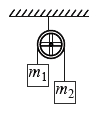The distance between two particles of masses m1andm2 is r. If the distance of these particles from the centre of mass of the system are r1andr2 respectively, then show that r1=r(m2m1+m2)andr2=r(m1m1+m2) Solution in Gujrati

Position vector of c.m.
→rcm=m1→r1+m2→r2m1+m2 ....(1)
Taking c.m. at the origin −−→rcm=→0
∴0=m1→r1+m2→r2[∵ From eq. (1)]
Now c.m. is on the line joining m1andm2 and the directions of →r1and→r2 are mutually opposite.
∴0=−m1r1+m2r2
∴m1r1=m2r2 ......(2)
∴m1(r1)=m2(r−r1)[∵r=r1+r2]
∴m1r1=m2r−m2r1
∴(m1+m2)r1=m2r
∴r1=r[m2m1+m2]
Again taking r1=r−r2 in m1r1=m2r2
∴m1(r−r2)=m2r2a
∴m1r−m1r2=m2r2
∴m1r=(m1+m2)r2
∴r2=r[m1m1+m2]
Topper's Solved these Questions
- SYSTEMS OF PARTICLES AND ROTATIONAL MOTIONBook:KUMAR PRAKASHANChapter:SYSTEMS OF PARTICLES AND ROTATIONAL MOTIONExercise:SECTION-C OBJECTIVE QUESTIONS (VSQs)
Explore 52 Videos
- SYSTEMS OF PARTICLES AND ROTATIONAL MOTIONBook:KUMAR PRAKASHANChapter:SYSTEMS OF PARTICLES AND ROTATIONAL MOTIONExercise:SECTION-D NCERT EXEMPLAR SOLUTIONS
Explore 13 Videos
- SYSTEMS OF PARTICLES AND ROTATIONAL MOTIONBook:KUMAR PRAKASHANChapter:SYSTEMS OF PARTICLES AND ROTATIONAL MOTIONExercise:SECTION-B ADDITIONAL EXERCISE
Explore 12 Videos
- QUESTIONS ASKED IN JEE - 2020 Book:KUMAR PRAKASHANChapter:QUESTIONS ASKED IN JEE - 2020 Exercise:Question
Explore 16 Videos
- THERMAL PROPERTIES OF MATTERBook:KUMAR PRAKASHANChapter:THERMAL PROPERTIES OF MATTERExercise:Question Paper (Section - D) (Answer following in brief :) Each carry 4 marks
Explore 1 Video
Similar Questions
Give two examples of a rigid body where the center of mass lies outside in material of rigid body.
View SolutionFor which of the following does the centre of mass lie outside the body?
View SolutionThe longest wavelength in Balmer series of hydrogen spectrum will be
View SolutionA non-isotropic solid metal cube has coefficient of linear expansion as 5×10−5/∘C along the x-axis and 5×10−6/∘C along y-axis and z-axis. If the coefficient of volumetric expansion of the solid is n×10−6/∘C then the value of n is....
View SolutionIn an experiment on the specific heat of a metal, a 0.20 kg block of the metal at 150∘C is dropped in a copper calorimeter (of water equivalent 0.025 kg) containing 150 cm3 of water at 27∘C. The final temperature is 40∘C. Compute the specific heat of the metal. If heat losses to the surroundings are not negligible, is your answer greater or smaller than the actual value for specific heat of the metal ?
View SolutionTwo concentric spherical shells have masses m_(1) and m_(2) and radii r_(1) and r_(2) (r_(2) gt r_(1)) . What is the force exerted by this system on a particle of mass m_(3) . If it is placed at a distance r(r_(1) lt r lt r_(2)) from the centre ?
View SolutionTwo stars of mass M1&M2 are in circular orbits around their centre of mass The star of mass M1 has an orbit of radius R1 the star of mass M2 has an orbit of radius R2 (assume that their centre of mass is not acceleration and distance between starts is fixed)
(a) Show that the ratio of orbital radii of the two stars equals the reciprocal of the ratio of their masses, that is R1/R2=M2/M1
(b) Explain why the two stars have the same orbital period and show that the period
T=2π(R1+R2)3/2√G(M1+M2) .
View SolutionTwo bodies of masses m1 and m2 are separated by a distance R. The distance of the centre of mass of the bodies from the mass m1 is
View SolutionTwo masses m1 and m2(m2>m1) are hanging vertically over frictionless pulley. The acceleration of the two masses is :

View SolutionTwo stars of masses m1andm2 are parts of a binary solar system. The radii of their orbits are r1andr2 respectively. The magnitude of the gravitational force m1 exerts on m2 is:
View SolutionTwo stars of masses m1andm2 are parts of a binary solar system. The radii of their orbits are r1andr2 respectively. The magnitude of the gravitational force m1 exerts on m2 is:
View SolutionTwo bodies of masses m_(1) and m_(2) are separated by a distance R. The distance of the centre of mass of the bodies from the mass m_(1) is
View SolutionThe position of centre of mass of a system consisting of two particles of masses m_(1) and m_(2) seperated by a distance L apart , from m_(1) will be :
View SolutionThe centre of mass of a system of two particles of masses m_(1)andm_(2) is at a distance a_(1) , from mass m_(1) and at a distance a_(2) from mass m_(2)0 such that :
View SolutionThe centre of mass of a system of two particles of masses m_(1) and m_(2) is at a distance d_(1) from m_(1) and at a distance d_(2) from mass m_(2) such
View Solution

